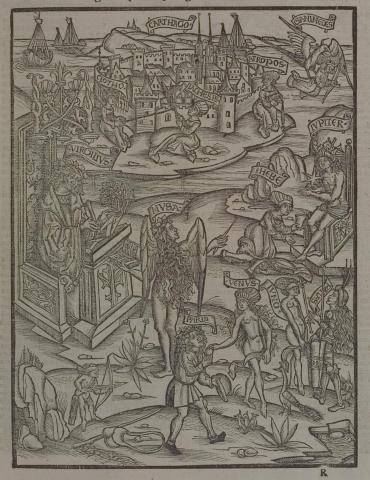Annotations
On the left, Vergil sits at an ornate lectern with a high-backed chair. While this is not explicitly in the poem, Vergil inserts himself in two places within the first several lines, with the first person verb cano in line 1, and then an appeal to the muse in lines 8-11. The Muse mentioned in line 8 stands in front of Vergil in the center of the image. In the lower right is the Judgment of Paris, which started the events leading up to the Trojan War; the event is mentioned in lines 26-7. Venus, Juno, and Pallas stand next to each other accompanied by their attributes; Paris gives the apple of discord to Venus, who reaches out her hand for it. Behind the three goddesses, Hebe gives Jupiter a cup. This detail comes from the commentary of Servius, who says that Hebe may have given to the gods the cups which Ganymede had the honor of bearing -'"honores' autem dixit vel propter ministerium poculorum, quod exhibuit diis remota Hebe, Iunonis filia" (1.28). Above them, Jupiter in the form of an eagle carries off Ganymede to make him cup-bearer (line 28). At the top of the image is Carthage, with the three Fates, Clotho, Lachesis, and Atropos, sitting in front holding their attributes. Carthage is introduced in lines 12-22, with half a line devoted to the will of the Fates at line 22. The Muse in the center of the image gestures broadly toward Carthage, highlighting its significance (Katy Purington).
Woodcut illustration from the “Strasbourg Vergil,” edited by Sebastian Brant: Publii Virgilii Maronis Opera cum quinque vulgatis commentariis expolitissimisque figuris atque imaginibus nuper per Sebastianum Brant superadditis (Strasbourg: Johannis Grieninger, 1502), fol. 121r, executed by an anonymous engraver under the direction of Brant.


Sebastian Brant (1458–1521) was a humanist scholar of many competencies. Trained in classics and law at the University of Basel, Brant later lectured in jurisprudence there and practiced law in his native city of Strasbourg. While his satirical poem Das Narrenschiff won him considerable standing as a writer, his role in the transmission of Virgil to the Renaissance was at least as important. In 1502 he and Strasbourg printer Johannes Grüninger produced a major edition of Virgil’s works, along with Donatus’ Life and the commentaries of Servius, Landino, and Calderini, with more than two hundred woodcut illustrations (Annabel Patterson).
Following Vergil's words very closely, Brant gives Book One a prefatory panorama (fig. 10). The first person voice of the epic speaker which opens the poem is made explicit in the figure of Vergil himself writing to the dictation of the Muse that passage following upon "Musa mihi causas memora" which searches into the background of the brooding wrath of Juno that pursues the hero throughout the poem. The Muse's pointing finger indicates Carthage, whose future destruction by the offspring of Troy is known to the Fates, and also to scenes of old grudges strongly remembered: Jove's elevation of the Trojan Ganymede; the humiliating Judgment of Paris. This, then, is an exploration of Juno's mind within the convenience of a fictive landscape (Eleanor Winsor Leach).